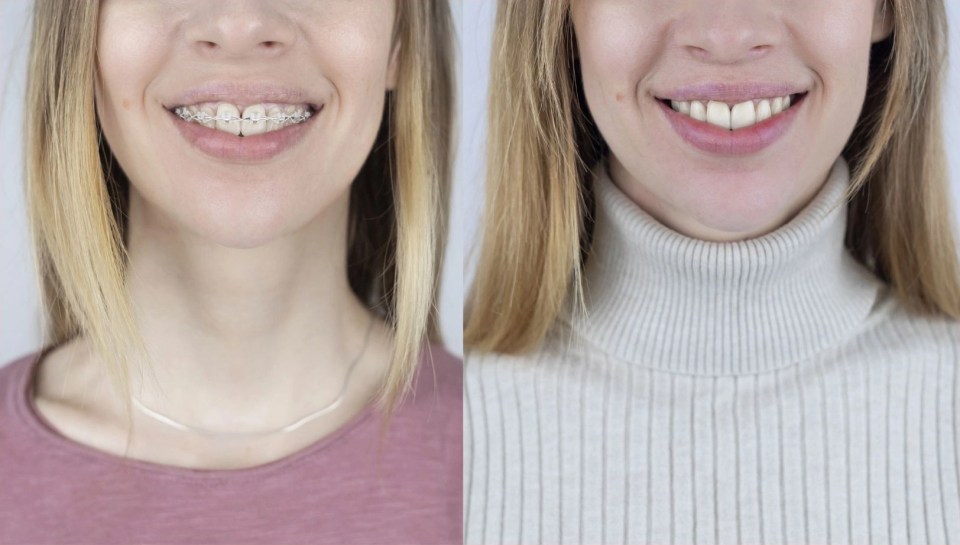Introduction:
Overbite occurs when the upper teeth excessively overlap the lower teeth, often due to a larger upper jaw and a smaller, recessed lower jaw. Correcting an overbite through braces or aligners can enhance facial balance by pulling back the upper teeth and improving the fit of the jaws. Braces not only straighten teeth but also can alter the face shape by aligning the upper jaw with the cheekbones and reducing the recessed appearance of the lower jaw. While braces are effective at any age, changes in facial structure are more noticeable in younger individuals due to more malleable bones. Even adults, however, can experience a more youthful appearance as their jawline improves. Additionally, orthodontic treatments can result in a more attractive smile by addressing misalignment and crowding.
These topics will be discussed in this Blog:
- What Is an Overbite?
- Jawline Before and After Braces: Face Shape
- Do braces improve your jawline?
- Can your smile change after braces?
- Will age matter with braces changing your face?
- Faq’s
What is an Overbite?
An overbite happens when your top teeth stick out too much over your bottom teeth. People with an overbite often have a bigger top jaw and a smaller bottom jaw tucked underneath. This can make the lower jaw look weak compared to the upper one.
Fixing an overbite pulls the teeth back and makes the top jaw less dominant than the bottom jaw. It makes the face look more balanced and even.
Jawline Before and After Braces: Face Shape
Braces can make your teeth look better, but they can also change your face. It doesn’t matter if you use metal braces, clear braces, or braces behind your teeth. When your top teeth move back, your upper jaw fits better with your cheekbones. And your lower jaw won’t be as tucked in, so it matches your face better.
Our Lightforce Braces work faster than regular braces, so you might notice the changes more. But even if you don’t see it right away, you’ll see the difference in the “before” photos we show you at the end. You’ll be surprised at how much your face has changed.

Do braces improve your jawline?
Getting braces or aligners might make your jawline look different or better. But if you want a big change in your jaw, you might need other things like expanders, special appliances, rubber bands, or even surgery along with braces or aligners. Your orthodontist will focus on fixing your bite first, then straightening your teeth. The best outcome of orthodontic treatment should make your teeth, smile, face, and jawline look nicer, while also making sure your bite feels good and stays that way.
Can your smile change after braces?
When you get braces, you’ll probably see a change in how your smile looks. Braces fix your teeth and how they fit together. So, depending on what you need, your smile might look straighter, and less crowded, or your teeth might be in new positions.
Will age matter with braces changing your face?
We often say you can get braces at any age, and it’s never too late for the smile you want. But it’s easier to move your teeth and change your face shape when you’re younger. Still, even as an adult, you might notice you look a bit younger after braces.
When you’re younger, your bones are still growing, so they’re easier to shape. This makes it easier to move your teeth and notice changes in your face shape. But as you get older, your bones become harder and don’t change as easily. This means moving your teeth is tougher, but not impossible. However, any changes to your face will be more subtle because your bones aren’t as flexible.
So, how does this make you look younger? Older patients might see their lower jaws move forward a bit, which can soften wrinkles and tighten the skin around the jaw. It’s not as dramatic as a facelift, but it’ll give you a slightly different look than before.
Faq’s
Q1. Do overbite braces change your face shape?
A1. Braces can change your face shape, but these effects are secondary to the repositioning of your teeth and bite. Yes, braces change your jawline, your chin, and even your lips. There is a possibility that braces may tighten your jawline and your teeth over time, but this is imperceptible over time.
Q2. How will my face change if I fix my overbite?
A2. When you have a large overbite, you can appear to have a weak chin and an undefined lower jaw due to your misaligned jaw and pronounced front teeth. Your protruding teeth and jaw alignment can be corrected with orthodontic treatment, which in turn can reshape your face slightly.
Q3. Does fixing an overbite fix the jawline?
A3. It works by putting pressure on the lower jaw for several months. An orthodontic treatment for overbites uses a dental appliance. The lower jaw will most likely grow forward for a longer period, thereby improving the bite and jawline.
Q4. Does an overbite affect your side profile?
A4. Having an overbite side profile and an exaggerated vertical overlap of the front teeth can make the chin appear smaller or less prominent due to an imbalance in the facial profile.
Q5. How do I get a better jawline with an overbite?
A5. Overbite correction methods include traditional braces, clear aligners, bite plates, or, in severe cases, surgery. These treatments fix an overbite while restoring your natural chewing patterns and enhancing your appearance.
Join the conversation. Explore our health blog library:







